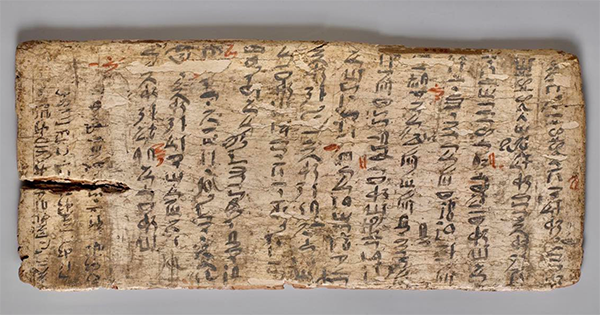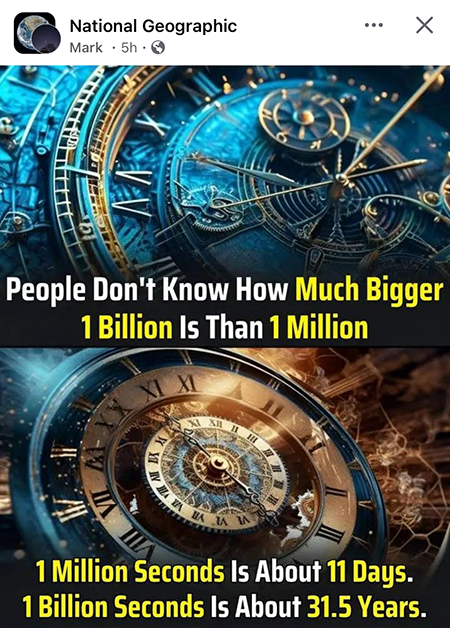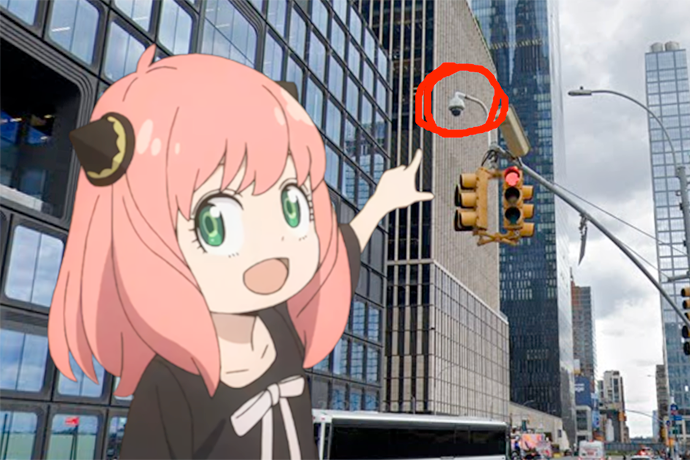Hello again and thank you for opening and reading! Today I have some interesting stories about technology. If you’re in New York City, there’s a project that lets you take selfies with traffic cameras. And a story about how people secured their letters hundreds of years ago. The world’s oldest failed test, complete with red marks from the teacher. And one of my favorite thought experiments, about whether or not advanced civilizations existed millions of years ago. Oh, and a Dad joke! Enjoy…
Letterlocking
Imagine you’re an adult in the 1500s in England. You’re writing a letter to a friend. How would you ensure your letter isn’t opened by anyone but your friend? How could your friend tell if the letter had been opened? Mary Queen of Scots had this problem the night before her execution in 1587. She wrote a letter to her brother in law. Then folded the letter a certain way to ensure its security. If opened by anyone but him, her brother in law would know.
Her solution to this problem is called letterlocking. People used to fold their letters in ways that made them secure for mail delivery. Then used a wax seal or other adhesive. If you like origami, letterlocking is similar. Except it uses a letter to make its own envelope.
The modern discovery of letterlocking happened in 2009. Jana Dambrogio, a conservator studying at the Vatican Secret Library, found mysterious letters. She figured out that people had folded the letters a specific way then sealed them with wax. Dambrogio and Daniel Starza Smith, a lecturer at Kings College London, expanded the search for letterlocking examples. In the process, they discovered dozens of ways people secured letters. Over hundreds of years or more, in many countries. With knowledge passed on person to person, family to family.
In 2012, researching at The Hague in the Netherlands, they found a chest filled with letters. Almost 600 letters were still letterlocked. In the 1700s, recipients paid for postage. The post office kept these letters for potential future payment. And then forgot them for hundreds of years.
Dambrogio and Starza Smith created a website with lots of videos to document their finds. It might be a fun project to watch then play with. And then see if you can send a letterlocked letter? Also, so you know, they’ve letterlocked their website: click the Click to Unlock button at the top left.
Researching this topic, I didn’t realize that envelopes are an 1800s invention. They evolved as a response to letterlocking. Certainly the mostly rectangular shape we recognize today. Plus the triangular top flap. Today, of course, many people send emails not letters.
Also, if you’re interested in writing letters, I found a fun 52 letters in a year challenge.
Letterlocking – MIT
http://letterlocking.org/
http://letterlocking.org/about
The clever folds that kept letters secret
https://www.bbc.com/future/article/20210616-how-the-forgotten-tricks-of-letterlocking-shaped-history
Introduction to the Art of Letterlocking – Johns Hopkins University
https://www.youtube.com/watch?v=3j62wBJnuog
Letterlocking
https://en.wikipedia.org/wiki/Letterlocking
Pushing the Envelope
https://www.smithsonianmag.com/history/pushing-the-envelope-144581278/
The History of the Envelope
https://blake-envelopes.com/blog/post/the-history-of-the-envelope
How Many Emails Are Sent Per Day? (2017-2027)
https://www.demandsage.com/how-many-emails-are-sent-per-day/
Michelle Houts’s 52 Letters in a Year Challenge
https://michellehouts.com/52-letters-in-a-year/
Take a Selfie with NYC Traffic Cameras
Awhile ago, I came across a story about using New York City traffic cameras to take selfies. Turns out an artist and programmer, Morry Kolman, uses camera feeds to create photographs. With any phone in NYC, go to TrafficCamPhotobooth.com. Find the nearest traffic camera, smile, then take a picture. The photo style can be either Polaroid or film strip. There’s no website version. The site only works using a phone. As his website puts it, “I do not want you to bring your laptop into traffic.”
While it’s a fun project, Kolman’s goal is more serious. Traffic cameras are everywhere. They’ve become invisible to most of us. They track what people and cars do all day and night. Plus they’re funded by taxpayers. Yet what happens to the footage is rarely discussed. The questions I would ask are, who has access on what terms? And is the data stored and, if so, where and how?
The code also is available for free on Github. It might make for a fun project for middle or high school kids, or curious adults, to dig into the code. There’s also a lot of other traffic cameras available online. Kolman’s Traffic Cam Photobooth website links to two other projects that use cameras. Searching online with “traffic cameras city” where city is the location also works. That’s how I found the CalTrans site with California traffic cameras.
Traffic Cam Photobooth
https://trafficcamphotobooth.com/
https://trafficcamphotobooth.com/about.html
https://github.com/wttdotm/traffic_cam_photobooth
Here’s how to take a selfie with a NYC traffic camera
How to take selfies with New York City’s traffic cameras
Real-Time Traffic Conditions & Cameras – NYC DOT
https://www.nyc.gov/html/dot/html/motorist/atis.shtml
Seattle Crime Cams, 2015
https://driesdepoorter.be/seattlecrimecams/
pig.observer
https://www.pig.observer/nyc/
https://www.pig.observer/seattle/
https://www.pig.observer/slc/
https://www.pig.observer/atlanta/
https://github.com/boringcactus/pig.observer
https://www.pig.observer/
Caltrans : Live Traffic Cameras
https://cwwp2.dot.ca.gov/vm/streamlist.htm
World’s Oldest Failed Test
There’s an awkward feeling that happens when you get school work back with lots of red marks. That’s not a feeling unique to us. Four thousand years ago, a student got their slate back with teacher edits in red. Apparently teacher’s have always marked up work with red. Not that I’m complaining. Only pointing out that the struggle is real, for students and teachers. And it’s at least 4,000 years of struggle.
I’d also note this slate looks awfully like some sort of large rectangular cracker? A very old cracker.

A 4,000-Year-Old Student ‘Writing Board’ from Ancient Egypt (with Teacher’s Corrections in Red)
https://www.openculture.com/2021/04/a-4000-year-old-student-writing-board-from-ancient-egypt.html
4,000-Year-Old Ancient Egyptian Writing Board Shows Student’s Spelling Mistakes
https://mymodernmet.com/ancient-egyptian-students-writing-board/
The Silurian Hypothesis
Earth is around 4.5 billion years. We humans have wandered the earth maybe six million years. Dinosaurs lived for about 165 million years. With erosion, tectonic plate movements, and the passage of time, fossils are rare.
Which leads to an interesting thought experiment. Can we tell if an ancient civilization existed hundreds of millions years ago? How much of human civilization will exist in two hundred or four hundred million years from now?
People call this thought experiment The Silurian Hypothesis, after a Doctor Who episode. If you don’t know, or live under a rock, Dr. Who is a British sci-fi TV show. It’s always been funny and thoughtful and interesting. The episode aired in 1970. It has ancient aliens called Silurians waking up from humans using nuclear power. Turns out the Silurians existed long before humans. And the earth slowly erased all signs of their existence.
In the real world, geologic processes could erase a complex ancient culture. For human culture, our roads and buildings might disappear over millions of years. But our use of nuclear technologies might leave traces of our existence. Same for plastics. The Silurian Hypothesis is suggests what to look for in the geologic record. If one or more cultures existed hundreds of millions of years ago, what traces might we find? What should we look for?
As an aside, as a Dr. Who fan, my favorite alien episode had British politicians as aliens and possibly Silurians. In one scene, they’re finally alone and unzip their human outfits. The aliens are bigger than the human suits they crawled into. They’re thrilled to stretch their legs, so to speak. It’s an odd funny twist in the episode. And some people do feel politicians must be aliens.
If you’re interested in other thought experiments, The Dark Forest is one of my favorite. It’s a response to the question, with a massive universe, where are the other civilizations? What prevents them from contacting us?
The Silurian hypothesis: would it be possible to detect an industrial civilization in the geological record?
An Advanced Civilization Could Have Ruled Earth Millions of Years Ago, Says the Silurian Hypothesis
https://www.discovery.com/exploration/Advanced-Civilization-Silurian-Hypothesis
Silurian hypothesis
https://en.wikipedia.org/wiki/Silurian_hypothesis
Doctor Who and the Silurians
https://en.wikipedia.org/wiki/Doctor_Who_and_the_Silurians
https://www.bbc.co.uk/programmes/p016219j/p01620vc
https://www.bbc.co.uk/programmes/profiles/2tCP23nKbS4DkJwKDFZyx1H/silurians
Dark forest hypothesis
https://en.wikipedia.org/wiki/Dark_forest_hypothesis
This Week
Our Sunday email this week will have fun often offbeat links about … Look for the email this Sunday.


